In the past couple of years, Google Ads has been implementing changes to its platform that encourage advertisers to utilize its automated features. However, advertisers have mixed feelings about this direction.
One of the prominent features is automated bidding, which has evolved over time but remains a complex aspect of Google Ads. There are multiple types of automated bidding strategies, each with its own advantages and disadvantages. So, should you embrace automated bidding? And if so, which strategy should you choose?
If you find yourself pondering these questions, you’ve come to the right place! This guide will provide you with insights on:
- The distinctions between manual, automated, and Smart bidding in Google Ads.
- How each of the nine bidding strategies in Google Ads operates.
- The appropriate scenarios for using each strategy, along with precautions to consider.
But before we dive into the details, let’s establish a solid understanding of the fundamentals.
Google Automated bidding: What is it?
When setting up a Google Ads campaign, you need to specify the amount you’re willing to pay for your ad to be displayed. This is known as your bid, and you have two options for setting your bids: manual or automated.
With manual bidding, you manually set the maximum amount you’re willing to pay per click on your ad (CPC). You have the flexibility to adjust your bid based on your ad’s performance using the available metrics in your reports.
On the other hand, automated bidding relies on Google’s automated rules to adjust your bids. These adjustments are based on factors such as the likelihood of your ad getting clicks or conversions. Automated bidding may incorporate additional data points that are not included in the standard reporting metrics.
Google Ads offers eight types of automated bidding options:
- Enhanced cost per click (ECPC)
- Maximize Clicks
- Maximize Conversions
- Maximize Conversion Value
- Target Cost Per Action (tCPA)
- Target Return on Ad Spend (tROAS)
- Viewable CPM (vCPM)
- Cost Per View (CPV)

Is Smart bidding the same as automated bidding?
Smart Bidding and automated bidding are terms that are sometimes used interchangeably, but they have distinct differences. Smart Bidding specifically refers to Google’s automated bidding strategies that utilize “auction-time bidding.” This means that Smart Bidding strategies optimize for conversions or conversion value in every individual auction. The Smart Bidding strategies offered by Google include:
- Enhanced CPC
- Maximize Conversions
- Maximize Conversion Value
- Target CPA
- Target ROAS
It’s important to note that while all Smart Bidding strategies are automated, not all automated bidding strategies fall under the category of Smart Bidding strategies.
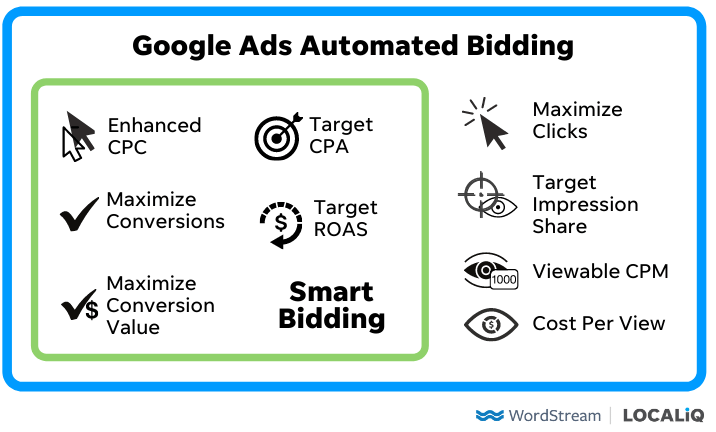
How do I choose my bid strategy? What options do I have?
When setting up your campaign, Google will automatically assign an automated bidding strategy based on your campaign goals. However, it’s important to note that you are not obligated to use this strategy. You have the flexibility to choose any other automated bidding strategy or even opt for manual bidding.
To select a different bidding strategy, simply click on the blue text at the bottom that says “Select a bid strategy directly (not recommended).”
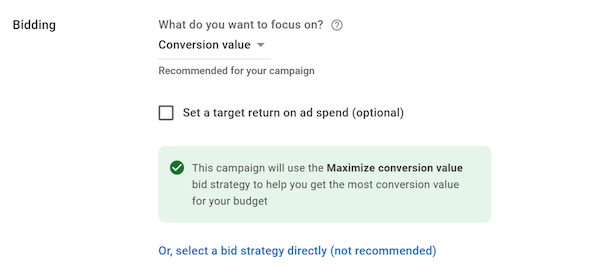
Now, let’s explore the various bidding options available in Google Ads:
1. Manual Cost Per Click (CPC):
Manual CPC bidding is the simplest bid strategy to understand in Google Ads. Advertisers manually set their bids at the keyword level, and these bids remain unchanged unless the advertiser decides to adjust them.

Regardless of the friendly warning from Google, starting with manual CPC is highly recommended for individuals who are new to PPC or have limited time to manage their accounts.
Despite the friendly warning from Google, this is an ideal starting point for beginners in PPC or for those who have limited time available to manage their accounts.
Cautions with Manual CPC:
Manual bidding comes with two notable drawbacks:
Time investment required: Managing manual bidding involves dedicating time to regularly assess performance, determine if keyword bids need adjustments, decide on the appropriate changes, and implement them.
Limited information: When relying on manual bidding, the performance metrics available are determined by Google, which means there may be data points that we are unaware of. In contrast, automated bidding strategies can leverage additional data points that may not be visible to us.
While these downsides don’t imply that all automation is superior or that manual bidding is unsuitable for everyone, they should be taken into consideration when selecting bid strategies.
2. Enhanced CPC
Enhanced CPC (ECPC) bidding is closely aligned with manual bidding, but with the added benefit of Google Ads algorithm making bid adjustments based on performance.
For those whose accounts are already performing well, ECPC serves as a suitable initial transition into automation. Enabling ECPC is straightforward; it can be done by selecting the checkbox below the manual bidding setting or choosing ECPC from the bidding type dropdown.
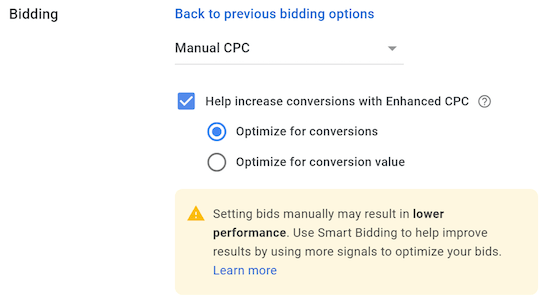
Enhanced CPC (ECPC) allows Google Ads to adjust keyword bids in individual auctions based on the probability of a click leading to a sale.
Previously, the bid adjustment range was limited to 30%, but now there is no cap, allowing Google Ads to adjust bids by any percentage. Additionally, ECPC offers the flexibility to optimize for either conversions or conversion value, depending on your goals.
Successful utilization of ECPC often leads to improved click-through rate (CTR) and conversion rate (CVR), which are common positive outcomes.
Cautions with Enhanced CPC
With the removal of the 30% adjustment cap in Enhanced CPC (ECPC), it becomes crucial to closely monitor your metrics.
Pay attention to CPC and CPA
As ECPC can adjust keyword bids without limitations, there is a possibility that bids and resulting CPCs could exceed what is profitable for your account.
While the goal of this bid type is to increase the likelihood of conversions, it may not always align with your target cost per conversion (CPA). It’s worth noting that the algorithm tends to increase bids more frequently than it decreases them.
Therefore, it’s important to keep a close watch on your click-through rate (CTR) and conversion rate (CVR) to ensure that the bidding strategy is performing as expected (both should show improvement). Additionally, track CPC and CPA to ensure that the results remain profitable for your campaign.
3. Maximizing Conversions
Maximize Conversions is a fully automated bidding strategy, in contrast to Enhanced CPC which is semi-automated. With Maximize Conversions, advertisers do not set individual keyword bids that Google considers. Instead, Google independently determines the CPC bid based on the objective of the bidding strategy.
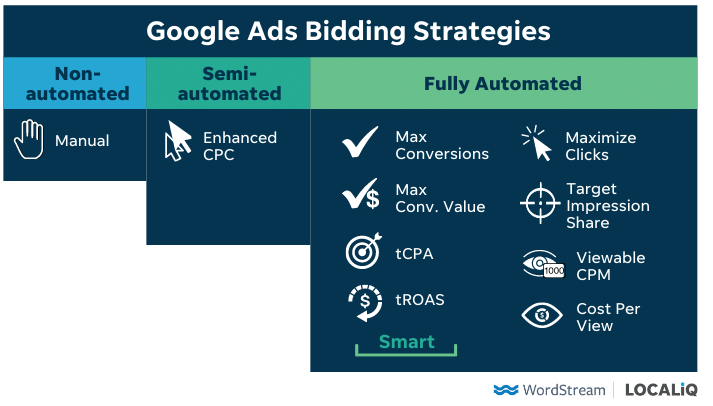
The Maximum Conversions bid strategy aims to maximize the number of conversions while utilizing your daily budget. Starting from April 2021, Max Conversions also offers the ability to include a target CPA, which assists in guiding its bidding decisions.

Cautions for Maximize Conversions
Caution should be exercised when implementing the Maximize Conversions bid strategy, as there are important considerations to keep in mind.
Allocate separate daily budgets for each campaign
It is crucial to assign a dedicated daily budget to each campaign utilizing the Maximize Conversions strategy. This ensures that the strategy focuses on spending the full daily budget allocated to that specific campaign. If multiple campaigns are part of a shared budget, Maximize Conversions may utilize the entire shared budget, exceeding the intended allocation for individual campaigns.
Ensure conversion tracking is enabled
It is imperative to have conversion tracking properly set up before utilizing the Maximize Conversions bid strategy. This strategy aims to maximize the number of tracked conversions. Without accurate conversion tracking, the algorithm may make suboptimal decisions in its bid optimization process, leading to ineffective results in finding potential converters.

Monitor your CPC closely
It is important to be vigilant about your CPC (cost per click) when utilizing the Maximize Conversions bid strategy. Google’s algorithm will bid aggressively to maximize conversions, which may result in increased spend or higher average CPC. However, the potential increase in conversion rate can help offset these higher costs. Although your spend or average CPC may be higher, the influx of conversions will lead to a lower overall CPA (cost per acquisition) and a higher return on investment (ROI). Additionally, with the option to set a target CPA, you have more control over managing these risks.
In summary, if your objective is to acquire more leads at a lower cost, Maximize Conversions could be a suitable strategy for you. However, if you have budget constraints, consider using a target CPA with Maximize Conversions or explore alternative bidding strategies.
4. Maximizing Clicks
This bidding strategy, known as Maximize Clicks, shares similarities with Maximize Conversions but places emphasis on generating clicks. When utilizing Maximize Clicks, Google’s objective is to obtain the maximum number of clicks while adhering to your daily budget.

This strategy can be highly effective when aiming to increase website traffic for branding purposes, building email lists, or if you already have a strong conversion performance and are seeking additional volume.
To maintain control over cost-per-click (CPC), advertisers have the option to set a maximum CPC limit. This ensures that CPCs stay within the desired range while Google works towards utilizing the entire daily budget.
Cautions with Maximize Clicks
It is essential to establish a maximum cost-per-click (CPC) and monitor the average max CPC closely when using this bid strategy. While Google aims to maximize clicks for your campaign, similar to Maximize Conversions, it also strives to exhaust your daily budget each day, even if it means higher-than-usual click costs.
Regularly assess the CPC performance and other relevant goal metrics associated with this bidding strategy to ensure it aligns with your objectives. If it falls short, consider adjusting your settings or exploring alternative bid strategies.
5. Maximize Conversion Value
Max Conversion Value can be considered the older sibling of the Max Conversions strategy, as it offers a slightly more advanced approach.
Although the two strategies share a fundamental similarity, Max Conversion Value aims to prioritize conversions that yield the highest return for your campaign.

Cautions with Max Conversion Value
There are two important considerations to keep in mind when using the Max Conversion Value bidding strategy.
Conversion tracking: As with Max Conversions, it is crucial to set up conversion tracking correctly for this strategy to be effective. Ensuring that conversions are accurately tracked will provide the necessary data for the algorithm to optimize bidding.
Assigning values: It is essential to assign values to each conversion action. By assigning values, the algorithm can prioritize and adjust bids based on the value of each conversion. For example, a conversion with a higher value should receive a higher bid compared to a conversion with a lower value. Properly setting up value-based bidding is necessary for the strategy to work effectively.
6. Target CPA (tCPA)
Target CPA, which stands for target cost per action or conversion, is a bidding strategy that allows you to set a specific cost goal for each conversion. Previously available as a separate bidding strategy, it is now offered as an option within the Max Conversions strategy.
When using target CPA (tCPA), you define the desired cost per action or conversion, and Google adjusts the bids to maximize the number of conversions achieved at that specific cost. This strategy aims to optimize your campaign to generate conversions efficiently and within your specified cost range.
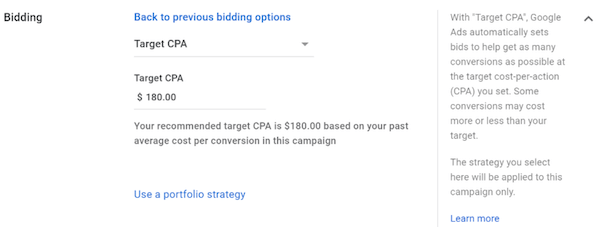
Advertisers have the ability to set bid limits to prevent Google from excessively adjusting bids either too low or too high. However, it’s important to note that these bid limits can only be applied at the portfolio level. If you are targeting individual campaigns, bid caps are not available for implementation.
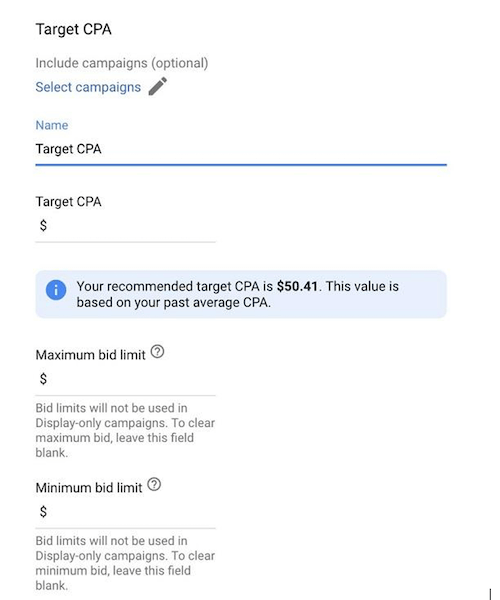
Cautions for Target CPA
There are three important considerations when it comes to Target CPA (tCPA) bidding.
Conversion tracking is essential: Similar to other bidding strategies like Max Conversions and Max Conversion Value, tCPA bidding relies on having conversion tracking properly set up in your account. Without accurate conversion tracking, this bidding strategy will not be effective in driving desired results.
Sufficient conversion data is required: In order for the algorithm to make informed decisions and optimize for conversions, a certain volume of conversion data is necessary. Google recommends a minimum of 15 conversions within the last 30 days at the campaign level, but it is advisable to aim for at least 30 to 50 conversions for more reliable results. If your campaigns do not meet this threshold individually, consider evaluating their performance at a portfolio level. If the conversion volume is still insufficient, tCPA bidding may not be suitable for your campaigns.
Set realistic target CPAs: When starting with tCPA bidding, it is important to set realistic initial goals. If your campaign has consistently achieved an average CPA of $40 over the past six months, it would not be wise to set a target CPA of $20 right from the start. Setting an overly ambitious target CPA may limit Google’s ability to participate in relevant auctions and learn effectively. It is recommended to start with a slightly higher target CPA, allowing Google to optimize and gradually reduce it over time towards your desired CPA.
When implementing tCPA bidding, keep in mind that the initial period (approximately two weeks to a month) is a learning phase. Use this time to let Google adapt and find its optimal bidding strategy. By gradually adjusting your target CPA based on performance, you can work towards achieving your desired cost per action.
7. Target ROAS (tROAS)
Spin text: Target ROAS (tROAS) is a bidding strategy that shares similarities with Target CPA, but focuses on maximizing return on ad spend (ROAS). Similar to tCPA, tROAS has been incorporated into the Max Conversion Value strategy (learn more here).
With tROAS, Google Ads utilizes historical data to forecast conversion and conversion value performance, enabling it to participate in relevant auctions and adjust bids in real time. The primary objective is to maximize conversion value while striving to achieve the target ROAS goal defined at the ad group, campaign, or portfolio level.
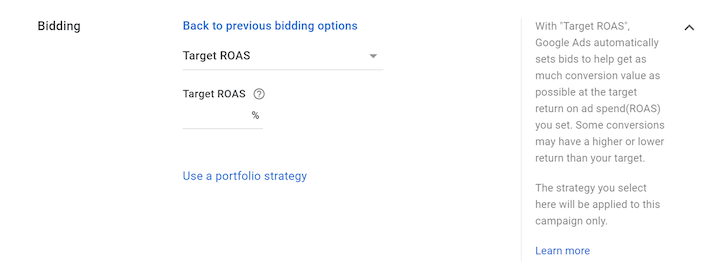
Like tCPA, the ROAS of individual conversions may vary, either exceeding or falling short of your desired target. Google employs strategies to strike a balance over time and reach the specified ROAS goal.
While using tROAS, advertisers have the option to set bid limits (minimums and maximums) at the campaign or portfolio level. However, Google advises caution when implementing these limits, as they can restrict the algorithm’s decision-making process.
Cautions for Targeting ROAS
The same considerations that apply to tCPA also apply to tROAS. It is crucial to have precise conversion tracking with assigned conversion values and an adequate history of conversion performance to effectively utilize this strategy.
Additionally, it’s important not to set an excessively high target ROAS right from the start. It is advisable to begin with a slightly lower goal than your recent performance and gradually increase the target over time to achieve a more profitable ROAS.
8. Target Impression Share
Target Impression Share is a relatively new bidding strategy that emerged from beta testing in 2018.
In this strategy, advertisers establish a desired impression share percentage, similar to how they would set a target CPA in other bidding strategies.
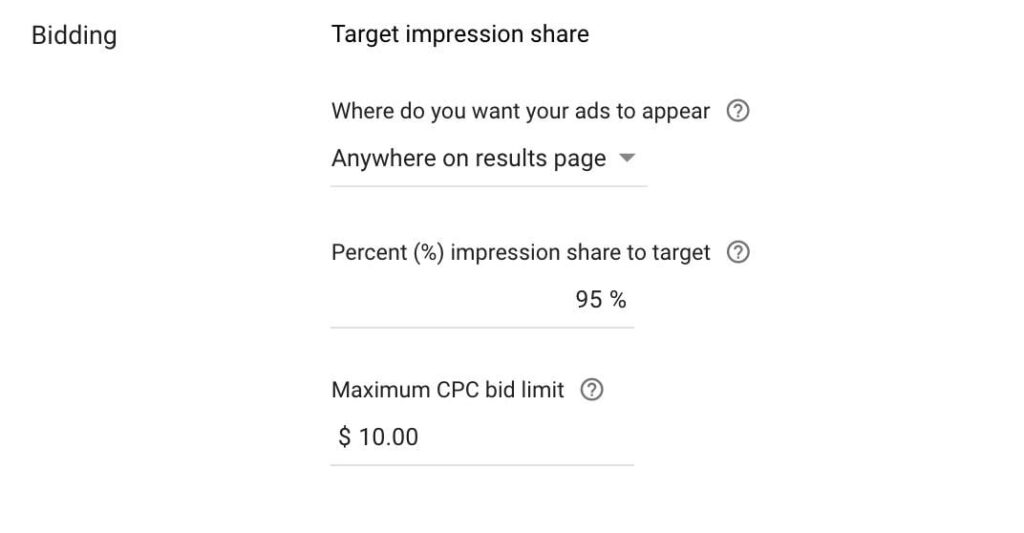
Target Impression Share offers three placement options to bid for:
- Absolute Top of Page
- Top of Page
- Anywhere on the Page
Each option communicates different preferences to the Google algorithm, which then adjusts bids accordingly.
To avoid overspending, advertisers can set a maximum CPC bid in Target Impression Share bidding. However, Google advises against setting it too low, as it may limit performance.
Cautions for Target Impression Share
As with any bidding strategy, it’s important to exercise caution to avoid bids that exceed profitability levels. While Target Impression Share focuses on awareness and reach, it’s crucial to consider the monetary feasibility of your campaigns.
Monitor CPC
Set a maximum CPC bid to prevent overpaying for individual clicks. Initially, don’t worry about setting it too low. Start with a 20%-50% increase over your current bid. If it yields satisfactory results, maintain that cap. If you desire more volume, consider increasing the maximum CPC.
Keep in mind that achieving 100% coverage in auctions is rare. Don’t be surprised or discouraged if your actual coverage is closer to 95%.
Continuously assess CPCs and performance outcomes to ensure that this bidding strategy aligns with your goals before committing to it further.
9. Viewable CPM
vCPM (Viewable CPM) is a metric that represents the cost per thousand viewable impressions. In the context of Google Ads, an ad is considered viewable when it is visible on the screen for a minimum duration of one second (for Display ads) or two seconds (for video ads), with at least 50% of the ad being in view.
Viewable CPM is a bidding strategy specifically tailored for Display ads, allowing advertisers to bid for impressions when their ads are displayed in viewable spaces.

vCPM bidding is an excellent choice when you aim to increase your brand exposure and reach a wide audience with your message.
Cautions for Viewable CPM
There are a few considerations to keep in mind when using vCPM bidding: frequency and placements.
Frequency: When utilizing vCPM bidding, Google aims to maximize the number of viewable impressions your ad receives. However, it’s essential to strike a balance and avoid bombarding a small audience with excessive ad frequency. While the goal is to increase ad views, it’s crucial to ensure that your brand doesn’t overwhelm users with a high frequency count.
Placements: Not all viewable impressions carry the same value. It’s important to regularly review your placements report to ensure that your ads are not appearing on undesired websites. Monitoring your ad placements helps maintain brand safety and ensures that your message is being displayed in relevant and appropriate contexts.
10. Cost Per View (CPV)
With Cost Per View (CPV) bidding, you have the option to bid on individual views, specifically for video ads. This bidding strategy allows you to set a campaign-level bid limit, indicating the maximum amount you’re willing to pay for each view or interaction with your video, whichever occurs first.
Under CPV bidding, you will only be charged for a view if a viewer watches your video for more than 30 seconds, or for the entire duration if the video is shorter than 30 seconds. However, if the viewer engages with other call-to-action elements such as clicking on a shared link or participating in actions like app downloads, you will be charged for those interactions instead.
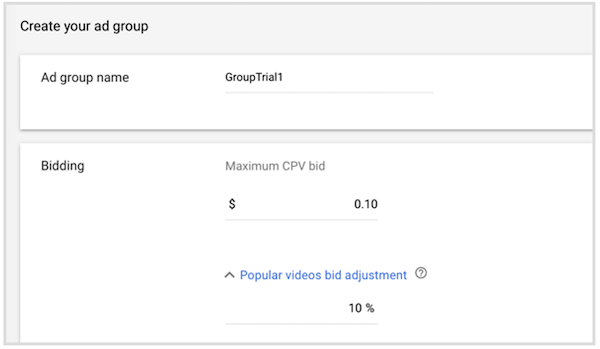
An advantage of CPV bidding is that it enables you to “bid up” when your ads are displayed alongside popular YouTube videos, which increases the likelihood of generating a higher return for your advertising efforts
Cautions with CPV
Be cautious if your video campaigns have loose targeting. If you’re attracting a large number of views at a lower cost, CPV bidding may not be the most suitable option for you.
Since CPV bidding focuses on individual views, it’s important to spend when it truly matters. Loose targeting can make it challenging to assess the effectiveness of your bids. Moreover, video views and average costs per view tend to be relatively inexpensive.
As a result, CPV is an excellent strategy for a highly targeted video campaign in a competitive environment. However, it may not be the most suitable choice for beginners in video advertising.
Which automated bidding strategy should I choose?
Now that we’ve explored all the automated bidding strategies, it’s important to understand that we don’t have to choose just one strategy for the entire account. The beauty of automated bidding and bid management is that we can customize and select different strategies for different parts of our account based on their specific goals.
In Google Ads, you have the flexibility to set automated bidding strategies at the ad group, campaign, or portfolio level, depending on the strategy you opt for. This means you can allocate different bid strategies to different components of your account based on their unique objectives.
When selecting a bid strategy, it’s crucial to evaluate it at the campaign level to determine if it aligns with your goals and if you have sufficient data to support its effectiveness (for example, enough conversion volume for Target CPA to work effectively). If the chosen strategy doesn’t meet your requirements, you might consider exploring alternative bid strategies, implementing a portfolio level strategy, or even adjusting your account structure to maximize its benefits in the future.
If you Set It, Don’t Forget It
Automated bid strategies in Google Ads offer a valuable time-saving solution by harnessing algorithmic optimization for your account. However, it is crucial to carefully evaluate and select the right strategies.
While automated bidding reduces the need for constant manual adjustments, it’s important to avoid the mindset of “set it and forget it.” Regular monitoring is essential to ensure that these strategies continue to align with your objectives. Set reminders to periodically assess their performance and make any necessary adjustments. Embrace the power of automation, but remain proactive in managing your campaigns for optimal result
